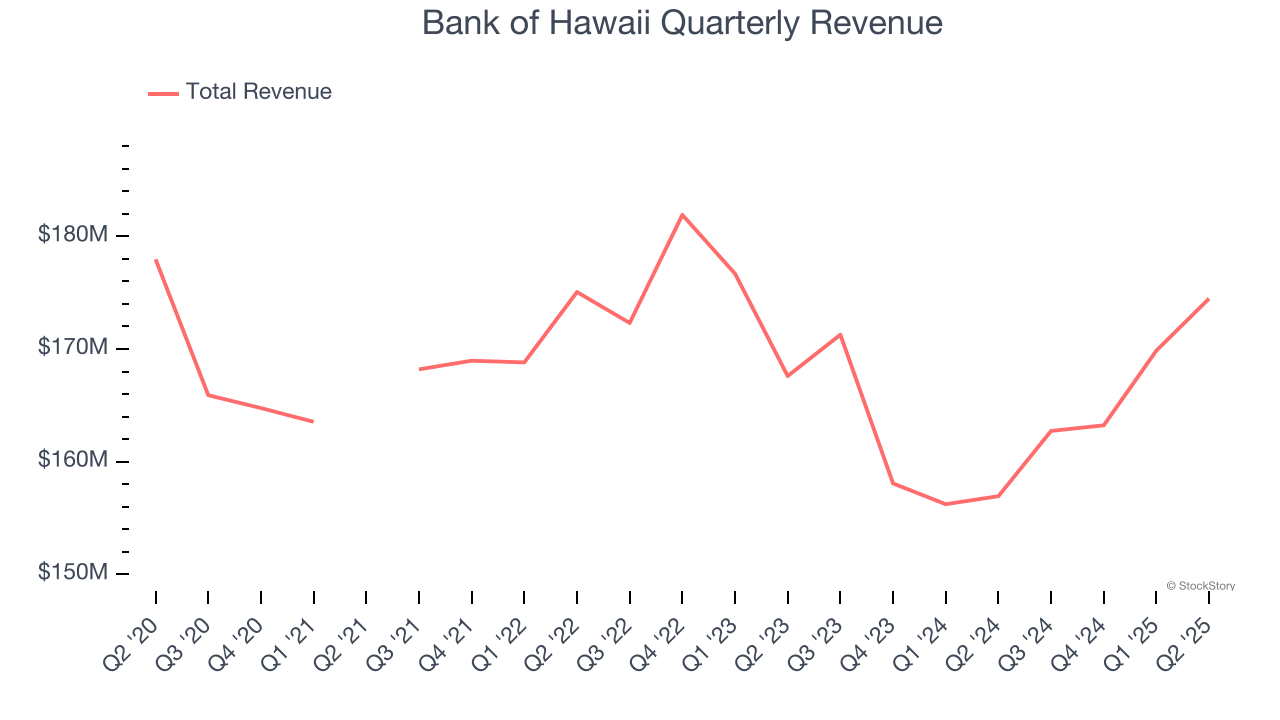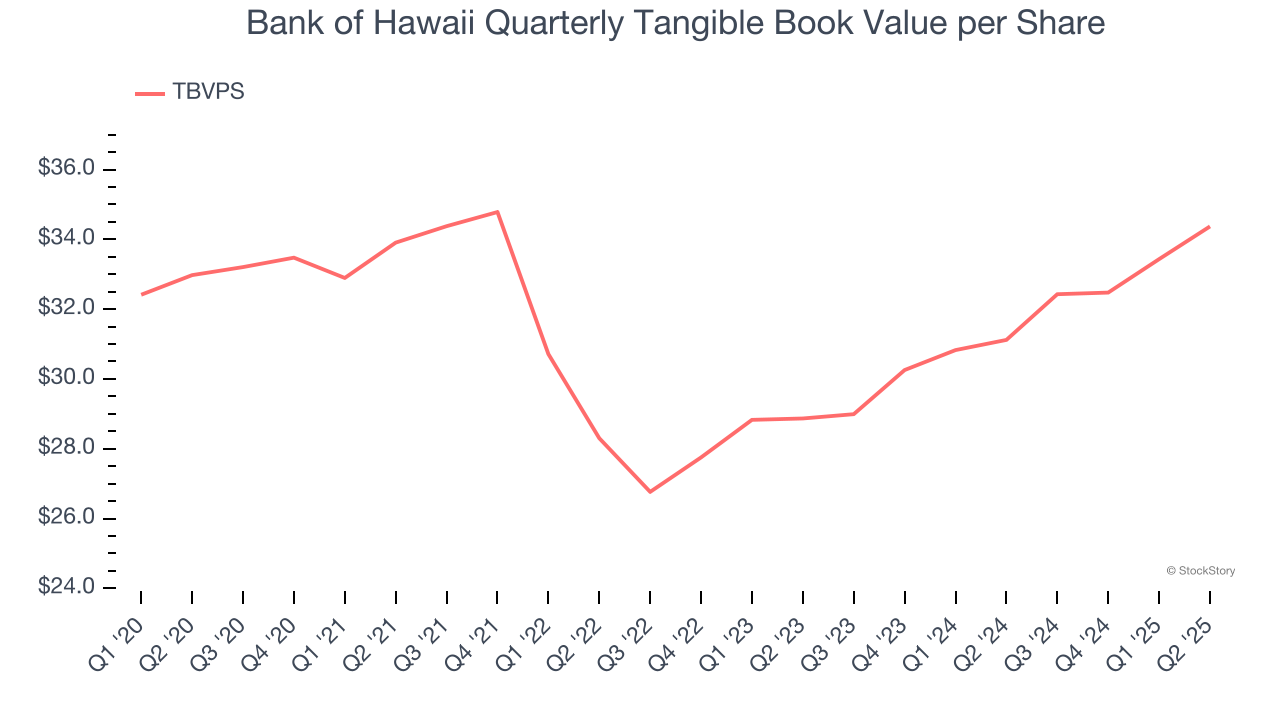
Regional banking institution Bank of Hawaii (NYSE:BOH) fell short of the market’s revenue expectations in Q2 CY2025, but sales rose 11.2% year on year to $174.5 million. Its GAAP profit of $1.06 per share was 1.7% above analysts’ consensus estimates.
Is now the time to buy Bank of Hawaii? Find out by accessing our full research report, it’s free.
Bank of Hawaii (BOH) Q2 CY2025 Highlights:
- Net Interest Income: $129.7 million vs analyst estimates of $132.7 million (12.9% year-on-year growth, 2.3% miss)
- Net Interest Margin: 2.4% vs analyst estimates of 2.4% (24 basis point year-on-year increase, 2.3 bps beat)
- Revenue: $174.5 million vs analyst estimates of $177 million (11.2% year-on-year growth, 1.4% miss)
- Efficiency Ratio: 63.5% vs analyst estimates of 62% (1.5 percentage point miss)
- EPS (GAAP): $1.06 vs analyst estimates of $1.04 (1.7% beat)
- Market Capitalization: $2.61 billion
“Bank of Hawai‘i continued to perform well during the second quarter of 2025,” said Peter Ho, Chairman and CEO.
Company Overview
Founded in 1897 as a financial anchor for the newly annexed Hawaiian territory, Bank of Hawaii (NYSE:BOH) is a financial institution providing banking, investment, and insurance services primarily to customers in Hawaii, Guam, and other Pacific Islands.
Sales Growth
From lending activities to service fees, most banks build their revenue model around two income sources. Interest rate spreads between loans and deposits create the first stream, with the second coming from charges on everything from basic bank accounts to complex investment banking transactions.
Unfortunately, Bank of Hawaii struggled to consistently increase demand as its $670.3 million of revenue for the trailing 12 months was close to its revenue five years ago. This wasn’t a great result and is a sign of lacking business quality.

Note: Quarters not shown were determined to be outliers, impacted by outsized investment gains/losses that are not indicative of the recurring fundamentals of the business.We at StockStory place the most emphasis on long-term growth, but within financials, a half-decade historical view may miss recent interest rate changes, market returns, and industry trends. Bank of Hawaii’s recent performance shows its demand remained suppressed as its revenue has declined by 2% annually over the last two years.
This quarter, Bank of Hawaii’s revenue grew by 11.2% year on year to $174.5 million but fell short of Wall Street’s estimates.
Net interest income made up 70.8% of the company’s total revenue during the last five years, meaning lending operations are Bank of Hawaii’s largest source of revenue.

Note: Quarters not shown were determined to be outliers, impacted by outsized investment gains/losses that are not indicative of the recurring fundamentals of the business.
Net interest income commands greater market attention due to its reliability and consistency, whereas non-interest income is often seen as lower-quality revenue that lacks the same dependable characteristics.
Software is eating the world and there is virtually no industry left that has been untouched by it. That drives increasing demand for tools helping software developers do their jobs, whether it be monitoring critical cloud infrastructure, integrating audio and video functionality, or ensuring smooth content streaming. Click here to access a free report on our 3 favorite stocks to play this generational megatrend.
Tangible Book Value Per Share (TBVPS)
The balance sheet drives banking profitability since earnings flow from the spread between borrowing and lending rates. As such, valuations for these companies concentrate on capital strength and sustainable equity accumulation potential.
When analyzing banks, tangible book value per share (TBVPS) takes precedence over many other metrics. This measure isolates genuine per-share value by removing intangible assets of debatable liquidation worth. Other (and more commonly known) per-share metrics like EPS can sometimes be murky due to M&A or accounting rules allowing for loan losses to be spread out.
Bank of Hawaii’s TBVPS was flat over the last five years. However, TBVPS growth has accelerated recently, growing by 9.1% annually over the last two years from $28.87 to $34.37 per share.

Over the next 12 months, Consensus estimates call for Bank of Hawaii’s TBVPS to grow by 11.5% to $38.31, solid growth rate.
Key Takeaways from Bank of Hawaii’s Q2 Results
The company's net interest income missed and its revenue fell slightly short of Wall Street’s estimates. On the other hand, EPS beat. Overall, this quarter was mixed. The stock traded up 1.1% to $66.35 immediately following the results.
Big picture, is Bank of Hawaii a buy here and now? If you’re making that decision, you should consider the bigger picture of valuation, business qualities, as well as the latest earnings. We cover that in our actionable full research report which you can read here, it’s free.
